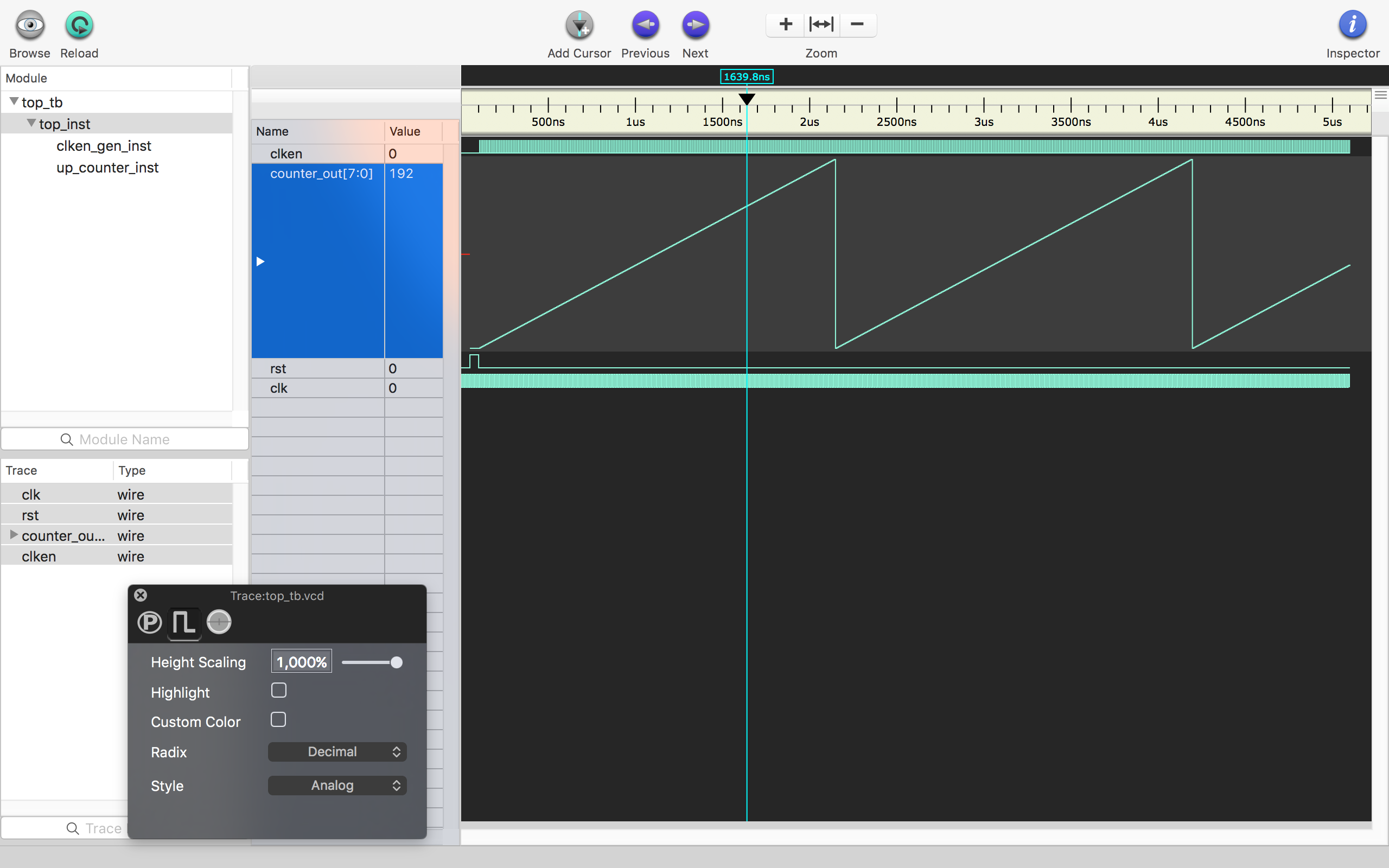OSX Based Minimal Verilog Simulation Toolchain
14 Sep 2016
Hi All,
I recently tried to make myself more comfortable to Verilog world with minimum big software tools. Then, I created a small solution for myself and put it on to GitHub. Below, you can find the Readme file that I prepared for the codebase.
You can check the repository from https://github.com/kehribar/verilog-osx
About
One can say VHDL is second class citizen in open source software / hardware world. For example, IceStrom project only supports Verilog. Furthermore, easy to use and FOSS simulators like Icarus Verilog and Verilator also (in stable sense) only support Verilog.
Here you can find a bare-bones, OSX based Verilog simulation toolchain that I created using several different tools. Everything should be working under Linux as well (expect Scansion) though I haven’t tested yet.
Description
There are four different Verilog source files:
up_counter.v: 8bit unsigned up counter with clock, reset and enable inputs.clken_gen.v: Clock enable pulse generator module with clock and reset inputs. Division ratio is parameterised.top.v: Main top module that instantiates an up_counter and clken_gen module.top_tb.v: Testbench module that instantiates the top module and feeds the neccessary test signals to the module.
If you want to change the example structure, see the Makefile then:
- Change
SRCSvariable with new source file names … - Change
TESTBENCHvariable for another test bench file name …
Also, if you want to change the resulting waveform file:
- Modify
$dumpfile("top_tb.vcd");line in the testbench code.
Commands
- Hit
make simulateto simulate the codebase and run the testbench using Icarus Verilog.- Testbench’s output stream ($display, $monitor function outputs and also any error/log messages) directed to $TESTBENCHNAME_log.txt file to make later analysis more convenient.
- Hit
make lintto trigger linting using Verilator. - Hit
make scansionto open up the Scansion application with recently created signal file. Only works under OSX. - Hit
make gtkwaveto open up the GTKWave application with recently created signal file. Not suggested for OSX. - Hit
make cleanto delete any generated files.
Prerequisites
- Icarus Verilog
- Run
brew install icarus-verilogto install on OSX system.
- Run
- Verilator
- Even though verilator itself also supports simulation, I’m only using it to ‘lint’ the codebase for any syntax / logical errors.
- Run
brew install verilatorto install on OSX system.
- GTKWave
- This application can be used to investigate .vcd waveform files. It was not very stable under OSX, so I moved on to other tool. Under Linux, this probably runs better.
- Run
brew install gtkwaveto install on OSX system.
- Scansion
- This application is used to investigate .vcd waveform files. It is OSX only. It works much better (more stable) than gtkwave under OSX.
- Visit http://www.logicpoet.com/scansion/ webpage to download the application. Makefile assumes that you put the OSX executable under /Applications/ folder. You can change it if you want.
- Sublime Text
- Sublime Text doesn’t support Verilog language as valid syntax extension. You should install https://packagecontrol.io/packages/Verilog package from package manager to have basic syntax coloring and couple of extra features for Verilog inside Sublime Text.
- You can, of course, use any other text editor as well. :)
Tips for analog waveform inspection
Scansion and GTKWave support visualising ports as analog waveforms. This feature is very useful in signal processing applications. Below you can see an example screenshot from Scansion:

Hit ⌘ + 2 to open Trace Inspector menu and select the desired signal. First, change the Style to Analog then adjust Height Scaling parameter to some high value to have bigger headroom in the display.
References
You should check these short but dense documents about Verilog:
- “Summary of Synthesisable Verilog 2001”
- “Verilog Tips, Pitfalls to Avoid”